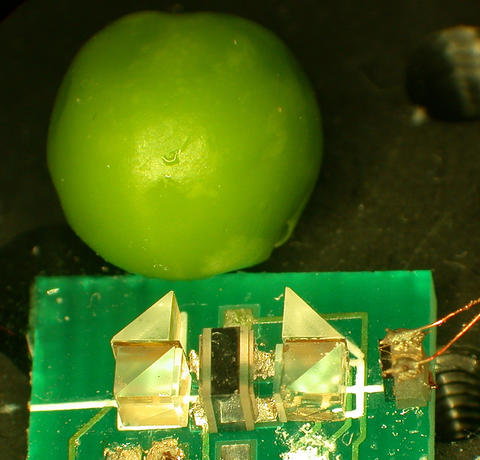
Photographed adjacent to an ordinary green pea, NIST's microfabricated spectrometer consists of a tiny container of atoms, a photodetector, and miniature optics.
A tiny device for calibrating or stabilizing precision lasers has been designed and demonstrated at the National Institute of Standards and Technology (NIST). The prototype device could replace table-top-sized instruments used for laser calibration in atomic physics research, could better stabilize optical telecommunications channels, and perhaps could replace and improve on the precision of instrumentation used to measure length, chemicals or atmospheric gases.
The new spectrometer, described in the May 7 issue of Optics Express, is the latest in a NIST series of miniaturized optical instruments such as chip-scale atomic clocks and magnetometers. The spectrometer is about the size of a green pea and consists of miniature optics, a microfabricated container for atoms in a gas, heaters and a photodetector, all within a cube about 10 millimeters on a side. The package could be used to calibrate laser instruments, or, if a miniature laser were included in the device, could serve as a wavelength or frequency reference.
Most of the optical components are commercially available. The key to the device is a tiny glass-and-silicon container—designed and fabricated at NIST—that holds a small sample of atoms. The sample chambers were micromachined in a clean room and filled and sealed inside a vacuum to ensure the purity of the atomic gas, but they can be mass-produced from silicon wafers into much smaller sizes, requiring less power and potentially cheaper than the traditional blown-glass containers used in laboratories. Although shrinking container size creates some limitations, NIST scientists have accommodated these difficulties by adding special features, such as heaters to keep more atoms in the gas state. NIST tests predict that the stability and signal performance of the tiny, portable device can be comparable to standard table-top setups.
The instrument works by measuring the intensity of a laser beam after it interacts with the atoms. The amount of light absorbed at a particular wavelength produces a characteristic signature. NIST has demonstrated the spectrometer with rubidium and cesium atoms, which absorb light at infrared, near-visible wavelengths, commonly used in atomic physics research. Different atoms or molecules, such as potassium or iodine, could be used for different applications. Or, a waveguide could be added to the device to double the frequency to stabilize lasers used in fiber-optic telecommunications. The mini-spectrometer would offer greater precision than the physical references now used to separate fiber-optic channels, with the advantage that more channels might be packed into the same spectrum.
S.A. Knappe, H.G. Robinson and L. Hollberg. Microfabricated saturated absorption laser spectrometer. Optics Express. May 7, 2007.

